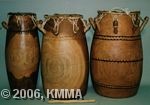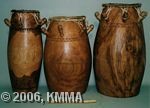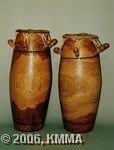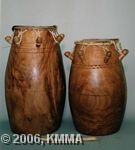







These three single-skinned open drums from the Anlo-Ewe music culture make up the traditional Ewe percussion set. The traditional music of the Anlo-Ewe was extensively studied by Alfred Kwashi Ladzepko and Kobla Ladzepko (University of Berkeley) and Andreas Meyer (1997 p. 70 - 75).
The kagan drum is the narrowest drum of the Anlo-Ewe percussion set. It
is approximately 50 to 60 cm high and has a diameter of 15 to 20 cm.
The sogo drum is approximately 70 cm high and has a diameter of 22 cm at the
top and 30 cm at the bottom. This drum widens in the middle to
approximately 35 to 40 cm. The drum is completely hollow inside and the
wall is approximately 2 cm thick. Some drums have a sound-hole at the
bottom of approximately 1.5 cm in diameter. This sound-hole is located 7 cm
from the bottom. The sound-hole allows the sound that is produced inside
the drum to travel outwards.
The kidi drum is the smallest of the Ewe percussion set, measuring 40
to 45 cm in height and 20 cm in diameter at the top and 25 cm at the
bottom. The wall of the drum is approximately 2 cm thick.
A membrane of goat hide is stretched across the top of the drum shell
and is attached with ropes to seven wooden conical pegs with which the
tension is adjusted to determine the pitch. The drums are struck with two
wooden drumsticks and are held diagonally between the legs with the drummer
seated behind the drum on a chair. The kagan drum produces a clear high
note, the highest in the percussion ensemble, and the sogo drum produces a
fairly high sound.
Within an ensemble, the sogo can be the lead-drum or an accompanying
instrument. When the sogo is the lead-drum, it is played like the
atsimevu.
The play technique is the same as for the sogo drum.
The kidi drum is played exclusively as an accompanying instrument for dances and songs.
When these drums accompany dances and songs, they are characterized by the way they play cross-rhythms.
Sometimes these drums are decorated with adinkra symbols or traditional decorative elements borrowed from nature, e.g. the sea and water. In some cases they are painted or decorated with geometrical figures and scored lines.
© RMCA/Dominik PHYFFEROEN